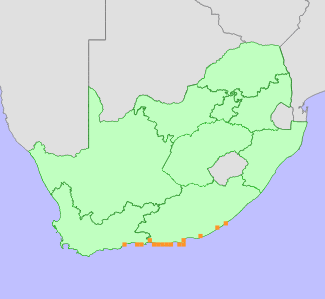|
Scientific Name | Cotula discolor (DC.) J.C.Manning & Mucina |
Higher Classification | Dicotyledons |
Family | ASTERACEAE |
Synonyms | Cenia discolor DC., Cenia pectinata DC., Cenia sericea (L.f.) DC. var. discolor (DC.) Harv., Cenia sericea in sense of DC., Cotula mariae K.Bremer & Humphries, Cotula sericea in sense of other authors, not of L.f. (misapplied name) |
National Status |
Status and Criteria | Least Concern |
Assessment Date | 2020/11/24 |
Assessor(s) | L. von Staden |
Justification | Cotula discolor is a widespread and common species, with an extent of occurrence (EOO) of 20 815 km². It is declining due to habitat loss across its coastal range, but is not yet in danger of extinction. It is therefore listed as Least Concern. |
Distribution |
Endemism | South African endemic |
Provincial distribution | Eastern Cape, Western Cape |
Range | This species is endemic to South Africa, and is found from Mossel Bay to East London. |
Habitat and Ecology |
Major system | Terrestrial |
Major habitats | Cape Seashore Vegetation, St Francis Dune Thicket, Southern Cape Dune Fynbos, Hamburg Dune Thicket, Goukamma Dune Thicket, Tsitsikamma Sandstone Fynbos, South Outeniqua Sandstone Fynbos, Knysna Sand Fynbos, Subtropical Seashore Vegetation, Kasouga Dune Thicket, Hartenbos Dune Thicket |
Description | It occurs on coastal dunes and cliffs. |
Threats |
| Cotula discolor is threatened by habitat loss to coastal development along most of its range. Some subpopulations are also threatened by competition from alien invasive plants. |
Population |
This species is very common, often dominant, in its coastal habitat. Subpopulations known through historical records from around Mossel Bay, Port Elizabeth and East London are now locally extinct due to habitat loss. Recent field observations indicate that it is however still very common, and remains at more than 20 locations.
|
Population trend | Decreasing |
Assessment History |
Taxon assessed |
Status and Criteria |
Citation/Red List version | | Cotula discolor (DC.) J.C.Manning & Mucina | Least Concern | 2015.1 | | Cotula mariae K.Bremer & Humphries | Least Concern | Raimondo et al. (2009) | |
Bibliography |
Goldblatt, P. and Manning, J.C. 2000. Cape Plants: A conspectus of the Cape Flora of South Africa. Strelitzia 9. National Botanical Institute, Cape Town.
Manning, J.C., Mucina, L. and Magee, A.R. 2013. Cotula sericea resolved as the correct name for the mysterious C. fallax (Asteraceae: Anthemidae), with new synonyms and the new combination Cotula discolor. South African Journal of Botany 88:237-242.
Raimondo, D., von Staden, L., Foden, W., Victor, J.E., Helme, N.A., Turner, R.C., Kamundi, D.A. and Manyama, P.A. 2009. Red List of South African Plants. Strelitzia 25. South African National Biodiversity Institute, Pretoria.
|
Citation |
| von Staden, L. 2020. Cotula discolor (DC.) J.C.Manning & Mucina. National Assessment: Red List of South African Plants version 2024.1. Accessed on 2025/12/07 |
 Comment on this assessment
Comment on this assessment


